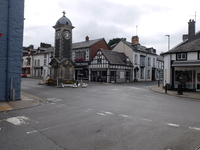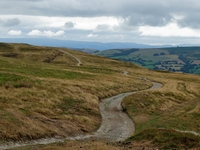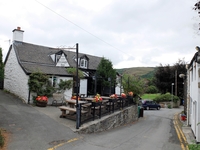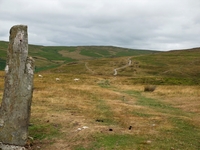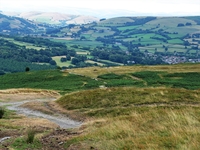Rhayader
Rhayader is at a busy crossroads (#1) at the foot of the Cambrian Mountains in Radnorshire – so busy that six tollgates used to guard the various entrances into the town1. The route to Rhayader used by drovers coming east from Aberystwyth (and monks from Strata Florida) has a good water supply nearly all the way, latterly the young River Wye, but the road was a hard one over the mountains, and it is still bleak (#2). David Jonathan never seems to have taken it: from Ceredigion he either went north-east via Welshpool or south-east via Tregaron.
These days Rhayader does well out of tourism, especially since the Elan Valley reservoirs were built. 150 years ago the picture was different: “a town of wretched mud hovels, fronted with a pig-sty, dunghill or both” was how David Williams described it. As an important road junction for farmers, inns were an important feature – and still are: Rhayader has 12 pubs catering for its population of 2,0002. The oldest and most famous is The Triangle (#3), on the western edge. You can see a large green meadow at the back of the picture, for grazing drovers' beasts, maybe. Beyond the meadow behind the trees is The Wye, so all thirsts were slaked3.
We took a taxi, I'm ashamed to say, up to our starting-point at SN 922706 and only walked the three miles downhill into the town. But we got the flavour, described by Richard Moore-Colyer as a “treeless countryside of peat bog and cotton grass”. The only living things besides sheep were the skylarks, bless ‘em. But it was a memorable walk all the same, with splendid views of the town below: the track was almost imperial, worn down to bedrock in many places. Maen-serth, the standing stone at 943698, is literally imperial too: it is said to mark the graves of two Welsh princes (#4).
(The story of one Rhayader inn is told amusingly by Tony Hobbs in “The Pubs of Radnorshire”. The Crown won the reputation of being, in the 1970's, the scruffiest bar in Britain – from the photos it also looks one of the happiest – when it was under the stewardship of its eccentric landlord Patrick Stancomb. “The dirt won't do you any harm, old boy”, customers were told by the ex-major, who was often found doing the Times crossword outside his pub and recommending would-be customers to go to The Lamb instead!)
1 This made the town an important target for the Rebecca rioters in the 1840's. Through the centre of town goes the London-Aberystwyth road (now the A44). It was Number One in Ogilby's map of 1675 and called The Great Road by the Turnpike trustees. We were made aware of its importance as we tried to get to sleep in a pub near the crossroads!
2 Which seems to be a record for pubs per head of population.
3 An additional attraction of The Triangle: they could cross the Wye from there & avoid the toll, then find the road to Nantmel. From there it was Birmingham or Worcester.







